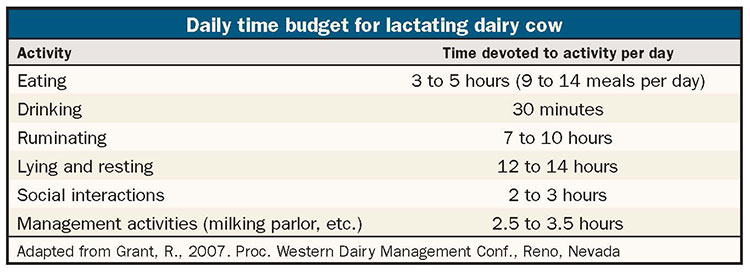
We all have learned a lot more about the importance of facilities and cow comfort by studying cows housed in freestall barns, which may include turn-out lots on dirt or pasture. This improved understanding of daily time budgets for lactating dairy cows is critical when building new facilities to match adequate milking parlor capacity and time cows spend away from their “home” pens.
At home, cows are able to meet their physical needs in the process of making milk by eating, drinking, resting, ruminating, and socializing. Let’s look at these needs to better understand their importance to the health, welfare, production, and reproductive success of your cows.
Daily time budget

Rick Grant of the Miner Institute and others have championed the importance of maintaining adequate time and space for lactating cows to perform their job of manufacturing one of nature’s most perfect foods — milk. Shown in the table are the time necessities of a lactating cow to maximize health and milk production. This point is stressed in my basic dairy science course so students can appreciate the complexity of a cow’s daily chores.
The first thing you notice is that the total time devoted to various activities listed in the table exceeds 24 hours. It should not be surprising to learn that these “Foster Mothers of the Human Race” are multitaskers, very similar to our own mothers. They are capable of doing several things at one time!
Eating and drinking activities are critical to obtaining the needed nutrients to produce milk, but rumination time is just as important because it facilitates digestion and feed passage. Lying and resting times also are very important to milk synthesis.
Cows produce slightly more milk when lying time is maximized because more nutrients are delivered to the mammary gland by enhanced blood flow. In one study, each additional hour of resting time was associated with 2 to 3.5 more pounds of milk produced each day. Other research indicated that lame cows had reduced resting time and lameness generally has a negative impact on milk production.
Cows must rest
To ensure cows have adequate lying time, they must have an available freestall. The incentive to utilize a stocking density above 100 percent (more than one cow per freestall) is driven by economics because the fixed cost of the building and production facilities is allocated over a greater number of cows. This economic driver, however, must be balanced by the impact limiting resting space has on cow comfort, behavior, and production.
The amount of time that cows rest or spend lying down is significantly influenced by their willingness to use freestalls. Availability of a stall does not necessarily mean that it will be used by cows.
Freestalls must be designed to allow cows to lie down easily and rise up again, with a comfortable bedding material. A good measure of stall comfort is to observe a very large percentage of cows lying down one to two hours after they return from the milking parlor.
Don’t overcrowd
The most pronounced negative impact upon cow resting or lying time is observed when stocking density reaches 120 percent and greater. In overcrowded situations, cows will spend more time standing idly waiting for a freestall space to become available so that they can lie down, indicating that cows will prioritize resting time over feeding time, and therefore, may not consume adequate amounts of feed to support milk production.
Reduction in lying time and greater standing time waiting for a stall to become available was found to have other detrimental health impacts:
1. Greater strain on hooves when cows are forced to stand on concrete for extended periods of time, in some cases, leading to greater incidence of lameness.
2. Increased blood cortisol as a stress response can lead to suppression of the immune system.
3. Less blood flow to the gravid uterine horn when cows are standing compared with lying down may possibly impact fetal growth.
Simply said, overcrowding leads to less lying time, lower milk fat, and greater somatic cell counts.
When planning new facilities, matching parlor capacity with cow numbers per pen will ensure that cows are not held away from feed, water, and resting areas more than one hour per milking time. Assuming no empty feedbunks, cows are deprived from water, resting, and socializing time when “locked up” too long every day at the feedbunk.
Time for socializing has its merits in both man and beast. With tongue-in-cheek, I tell my students that socializing time is when cows “Facebook” and “Tweet” or when a cow “Moos.”
But seriously, it is during these social interactions when cows express estrus and interact with other cows that are in heat. Adequate space and time are critical for these events to occur. Sure-footing and space for standing and mounting activities are paramount to achieving excellent heat detection and insemination rates.
Despite the merits and success of timed A.I. breeding programs, heat detection should still be an important component of your reproductive program. Happy A.I. breeding!








